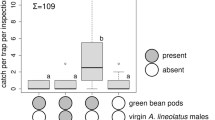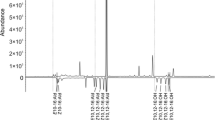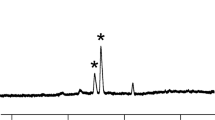Abstract
The plant bugs Lygus hesperus, Lygus lineolaris, and Lygus elisus (Hemiptera: Miridae) are major pests of many agricultural crops in North America. Previous studies suggested that females release a sex pheromone attractive to males. Other studies showed that males and females contain microgram amounts of (E)-4-oxo-2-hexenal, hexyl butyrate, and (E)-2-hexenyl butyrate that are emitted as a defense against predators. Using gas chromatography–mass spectrometry, we found that female L. lineolaris and L. elisus have a 4:10 ratio of hexyl butyrate to (E)-2-hexenyl butyrate that is reversed from the 10:1 ratio in female L. hesperus (males of the three species have ~10:1 ratio). These reversed ratios among females of the species suggest a behavioral role. Because both sexes have nearly equal amounts of the major volatiles, females should release more to attract males. This expectation was supported because L. hesperus females released more hexyl butyrate (mean of 86 ng/h) during the night (1800–0700 hours) than did males (<1 ng/h). We used slow-rotating pairs of traps to test the attraction of species to blends of the volatiles with a subtractive method to detect synergism. Each species’ major butyrate ester was released at 3 μg/h, the minor butyrate according to its ratio, and (E)-4-oxo-2-hexenal at 2 μg/h. The resulting catches of only Lygus males suggest that (E)-4-oxo-2-hexenal is an essential sex pheromone component for all three species, (E)-2-hexenyl butyrate is essential for L. elisus and L. lineolaris, and hexyl butyrate is essential for L. hesperus. However, all three components are recognized by each species since ratios of the butyrate esters are critical for conspecific attraction and heterospecific avoidance by males and thus play a role in reproductive isolation among the three species. Because L. hesperus males and females are known to emit these major volatiles for repelling ant predators, our study links defensive allomones in Lygus bugs with an additional use as sex pheromones.




Similar content being viewed by others
References
Aldrich JR, Lusby WR, Kochansky JP, Hoffmann MP, Wilson LT, Zalom FG (1988) Lygus bug pheromones, vis-à-vis stink bugs. Proceedings Beltwide Cotton Production Research Conferences, pp. 213–216
Baker TC, Roelofs WL (1981) Initiation and termination of oriental fruit moth male response to pheromone concentrations in the field. Environ Entomol 10:211–218
Blackmer JL, Byers JA (2009) Lygus spp. (Heteroptera: Miridae) host–plant interactions with Lesquerella fendleri (Brassicaceae), a new crop in the arid southwest. Environ Entomol 38:159–167
Brent CS, Byers JA (2011) Female attractiveness modulated by a male-derived antiaphrodisiac pheromone in a plant bug. Anim Behav 82:937–943
Byers JA (1988) Novel diffusion–dilution method for release of semiochemicals: testing pheromone component ratios on western pine beetle. J Chem Ecol 14:199–212
Byers JA (1992) Optimal fractionation and bioassay plans for isolation of synergistic chemicals: The subtractive–combination method. J Chem Ecol 18:1603–1621
Byers JA (2005) A cost of alarm pheromone production in cotton aphids, Aphis gossypii. Naturwissenschaften 92:69–72
Byers JA (2006) Production and predator-induced release of volatile chemicals by the plant bug Lygus hesperus. J Chem Ecol 32:2205–2218
Byers JA (2013) Modeling and regression analysis of semiochemical dose–response curves of insect antennal reception and behavior. J Chem Ecol 39:1081–1089
Byers JA, Schlyter F, Birgersson G, Francke W (1990) E-myrcenol in Ips duplicatus: An aggregation pheromone component new for bark beetles. Experientia 46:1209–1211
Byers JA, Zhang QH, Birgersson G (2004) Avoidance of nonhost plants by a bark beetle, Pityogenes bidentatus, in a forest of odors. Naturwissenschaften 91:215–219
Byers JA, Birgersson G, Francke W (2013) Aggregation pheromones of bark beetles, Pityogenes quadridens and P. bidentatus, colonizing Scotch pine: olfactory avoidance of interspecific mating and competition. Chemoecology in press
Clancy DW, Pierce HD (1966) Natural enemies of some Lygus bugs. J Econ Entomol 59:853–858
Debolt JW (1982) Meridic diet for rearing successive generations of Lygus hesperus. Ann Entomol Soc Am 75:119–122
Debolt JW, Patana R (1985) Lygus hesperus. In: Singh P, Moore RF (eds) Handbook of insect rearing, vol 1. Elsevier, New York, pp 329–338
Frati F, Chamberlain K, Birkett M, Dufour S, Mayon P, Woodcock C, Wadhams L, Pickett J, Salerno G, Conti E, Bin F (2009) Vicia faba–Lygus rugulipennis interactions: induced plant volatiles and sex pheromone enhancement. J Chem Ecol 35:201–208
Graham HM (1987) Attraction of Lygus spp. males by conspecific and congeneric females. Southwest Entomol 12:147–154
Graham HM (1988) Sexual attraction of Lygus hesperus Knight. Southwest Entomol 13:31–37
Ho HY, Millar JG (2002) Identification, electroantennogram screening, and field bioassays of volatile chemicals from Lygus hesperus Knight (Heteroptera: Miridae). Zool Studies 41:311–320
Innocenzi PJ, Hall DR, Cross JV, Masuh H, Phythian SJ, Chittamaru S, Guarino S (2004) Investigation of the European tarnished plant bug, Lygus rugulipennis: Chemical, electrophysiological, and field studies. J Chem Ecol 30:1509–1529
Innocenzi PJ, Hall D, Cross JV, Hesketh H (2005) Attraction of male European tarnished plant bug, Lygus rugulipennis to components of the female sex pheromone in the field. J Chem Ecol 31:1401–1413
Kelton LA (1975) The Lygus bugs (genus Lygus Hahn) of North America (Heteroptera: Miridae). Mem Entomol Soc Can 95:1–101
Klun JA, Chapman OL, Mattes KC, Wojtkowski PW, Beroza M, Sonnet PE (1973) Insect sex pheromones: minor amount of opposite geometrical isomer critical to attraction. Science 181:661–663
Löfstedt C, Herrebout WM, Menken BJ (1991) Sex pheromones and their potential role in the evolution of reproductive isolation in small ermine moths (Yponomeutidae). Chemoecology 2:20–28
Moreira JA, Millar JC (2005) Short and simple syntheses of 4-oxo-(E)-2-hexenal and homologs: Pheromone components and defensive compounds of Hemiptera. J Chem Ecol 31:965–968
Mueller AJ, Stern VM (1973) Lygus flight and dispersal behavior. Environ Entomol 2:361–364
Mueller SC, Summers CG, Goodell PB (2003) A field key to the most common Lygus species found in agronomic crops of the central San Joaquin Valley of California. Univ Calif Agric Nat Res Pub 8104:1–12
Rancourt B, Vincent C, De Oliveira D (2000) Circadian activity of Lygus lineolaris (Hemiptera: Miridae) and effectiveness of sampling techniques in strawberry fields. J Econ Entomol 93:1160–1166
Scales AL (1968) Female tarnished plant bugs attract males. J Econ Entomol 61:1466–1467
Scott DR (1977) An annotated listing of host plants of Lygus hesperus Knight. Bull Entomol Soc Am 23:19–22
Stern VM, Mueller A (1968) Techniques of marking insects with micronized fluorescent dust with especial emphasis on marking millions of Lygus hesperus for dispersal studies. J Econ Entomol 61:1232–1237
Strong FE, Sheldahl JA, Hughes PR, Hussein EMK (1970) Reproductive biology of Lygus hesperus Knight. Hilgardia 40:105–147
Wardle AR, Borden JH, Pierce HD Jr, Gries R (2003) Volatile compounds released by disturbed and calm adults of the tarnished plant bug, Lygus lineolaris. J Chem Ecol 29:931–944
Westfall PH, Tobias RD, Rom D, Wolfinger RD, Hochberg Y (1999) Multiple comparisons and multiple tests using SAS. SAS Institute, Cary
Yasuda T, Shigehisa S, Yuasa K, Okutani-Akamatsu Y, Teramoto N, Watanabe T, Mochizuki F (2008) Sex attractant pheromone of the sorghum plant bug Stenotus rubrovittatus (Matsumura) (Heteroptera: Miridae). Appl Entomol Zool 43:219–226
Young OP (1986) Host plants of the tarnished plant bug, Lygus lineolaris (Heteroptera: Miridae). Ann Entomol Soc Am 79:747–762
Zhang QH, Aldrich JR (2003) Male-produced anti-sex pheromone in a plant bug. Naturwissenschaften 90:505–508
Acknowledgments
We thank LeAnne Elhoff for the technical assistance. We are grateful to Prof. David R. Hall of University of Greenwich, UK, for sharing his synthetic experience with 4-oxo-alkenals. We thank Dr. Ezra Dunkelblum (ARO Volcani Center Israel) for the constructive comments regarding this manuscript. Mention of trade names or commercial products in this article is solely for providing specific information and does not imply recommendation or endorsement by the U.S. Department of Agriculture. USDA is an equal opportunity provider and employer.
Author information
Authors and Affiliations
Corresponding author
Additional information
Communicated by: Sven Thatje
Rights and permissions
About this article
Cite this article
Byers, J.A., Fefer, D. & Levi-Zada, A. Sex pheromone component ratios and mating isolation among three Lygus plant bug species of North America. Naturwissenschaften 100, 1115–1123 (2013). https://doi.org/10.1007/s00114-013-1113-7
Received:
Revised:
Accepted:
Published:
Issue Date:
DOI: https://doi.org/10.1007/s00114-013-1113-7




